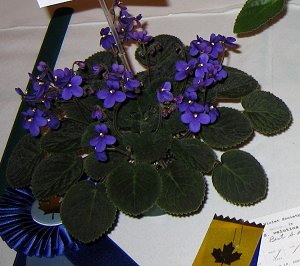Species
 History
of the Species
History
of the Species
1. The African violet was first discovered in East Africa in 1892 by Baron Walter von St. Paul.
2. Over 20 wild species and variants have been found to date.
3. All wild species have blossoms in the blue-violet range, but other characteristics vary.
4. African violets came to North America via Europe in 1926.
5. The highly varied modern varieties are the result of hybridization.
The African violet really is an African plant. While it presumably grew
uncelebrated by botanists and plant-lovers for countless millennia it had to
wait until 1892 for its official discovery by the Baron Walter von Saint
Paul, the German governor of a northeastern province in Tanganyika, now part
of Tanzania. Von Saint Paul found the plant growing among shaded rocky
ledges in the Usambara Mountains. He immediately sent seeds of his "Usambara
violet" to his father in Germany. In Germany the plant acquired a botanical
name which it still bears today: Saintpaulia. Other species closely related
to this first were soon discovered. They all bear the genus name Saintpaulia
plus an adjective describing the individual species. The original plant
discovered by Walter von Saint Paul is Saintpaulia ionantha. There are more
than twenty other similar but certainly not identical species in the genus.
They have memorable names betraying what those naming them thought of them
such as: Saintpaulia difficilis, S. confusa, S. inconspicua. Others have
adjectival names indicating place of origin: S. magungensis, S. teitensis,
S. tongwensis. Magunga, Teita, and Tongwe are all place names associated
with Tanzania.
The African violet enjoyed some success as a houseplant in Germany and other
European countries and was brought to this continent by the California firm
of Armacost and Royston in 1926 when they imported seeds from the German and
British greenhouses that had specialized in the plant; The varieties that
Armacost and Royston grew from these first batches of seed are still often
grown today. All were basic blue in bloom colour and the bloom type was the
standard single, pansy-shaped blossom we associate with African violets.
Sometimes the foliage is multi-crowned or trailing as the species have a
variety of growth habits.
Not all African violets today have the pansy-shaped, blue blossoms that led
to the popular name of the plant. Hybridizers' efforts over the past many
decades have succeeded in bringing us new plant sizes and growth habits,
blossom colours, and many other changes which add enormous variety to a
collection of African violets. More about that under the topic
Hybridization.




